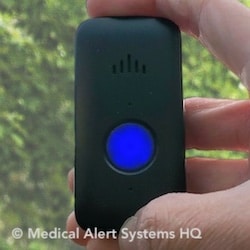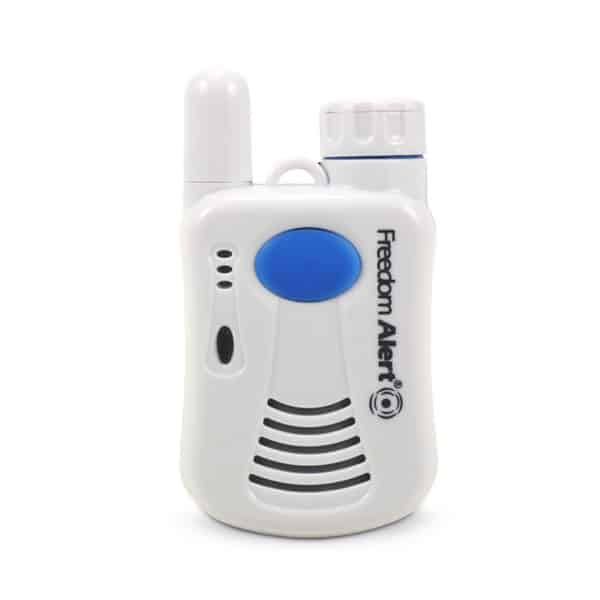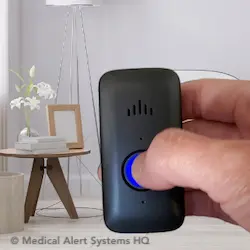Last Updated on March 5, 2023
The main purpose of medical alert devices for the elderly is to communicate with healthcare providers, family members and emergency medical personnel when threatening emergency situation arise. They are indeed useful tools, especially for the elderly living alone. Almost all are easy to use, and the alerts or information are transmitted at one touch of a button. For the users, this means living independently with a lot less worries for themselves and their loved ones.
In this article, we will cover four types of medical alert monitoring devices. These are monitored medical alert systems, non monitored or no monthly fee medical alerts, mobile devices, and medical alert USB drives. Each of these devices is equipped with useful features that may be useful for you and your elders.
We have a separate list on Personal Safety Devices for the Elderly that covers smartwatches, wireless caregiver pagers, and smart speakers. See the full list here.
Mobile Medical Alert Devices

A mobile medical alert button that connects through a cellular network to monitoring help around the clock. This is the modern version of the traditional Life Alert button, but they connect through a wireless network like Verizon 4G LTE or AT&T Wireless.
Unlike the previous generation life alert systems, these are not tethered to a landline. The owner can keep their pocket-sized device with them at all times. Once help is needed, they can be called whenever and wherever an incident occurs (wherever there is cellular coverage). These standalone on-the-go mobile buttons do need to be paired with a home medical alert system base unit to work.
LifeFone VIPx Example
Mobile alert units come with pendants which can be worn with a neck lanyard or else fitted into a belt clip case.
An advanced mobile medical alert device like the LifeFone VIPx is small and lightweight. It works just like a mobile phone in that calls are connected through a cell phone network connection; and the device comes with a speaker and microphone for two-way conversations.
To access help, the senior or system user should press the SOS button on their device. The VIPx’s Artificial Intelligence mechanism will immediately respond and route them to an operator if needed. Here’s a quick demo:
Questions? Call toll-free 1-877-352-1292 or visit LifeFone’s Official Website
GPS Tracking
The LifeFone VIPx has also been fitted with GPS tracking. Wherever the elderly may be, at home, or anywhere outside the house, such as on a shopping trip, the monitoring operator will be able to retrieve their GPS location in real-time.
This tracking feature could be an enormous benefit in situations where he device user does not know where he or she is. An optional caregivers app will allow caregivers to request for the device location at will, providing even more peace of mind.
For some seniors, fall detection can be an additional option. To learn more, call LifeFone at 1-877-352-1292.
Monitored In-Home Medical Alert Systems
Questions? Call toll-free 1-855-397-9964 or visit Bay Alarm Medical’s website
Monitored medical alert systems are probably one of the most popular medical alerts for seniors. This is a device that allows the patient to be connected to an emergency monitoring service that operates round the clock. Some people also refer to this as a Life Alert system, as Life Alert is a well-known brand that offers monitored medical alert systems.
The wearable SOS button for these devices comes in the form of bracelet or necklace pendant which are waterproof. Since the pendant is light in weight (in contrast to the heavier base speaker unit), the elderly customer can comfortably wear it all the time.
Among the top companies that offer these devices are Bay Alarm Medical, LifeStation and Medical Guardian.
Which is Best?
Out the these top names, we recommend the Bay Alarm Medical one (pictured above) because we found that their system is easy to set-up, offered above-average in response speed, and has good backup battery life for better reliability (see review). You will find it slightly less costly than other brands, offering a hard-to-beat combination of both value and quality. Watch a demo
How It Works
Once the button is pressed, it sends a signal to the base station which then calls the emergency monitoring center. The connection is done either through a land phone line or cellular connection. A trained operator will be ready to provide assistance. Once the operator assesses the problem at hand, he may dispatch emergency first responders to address a medical situation, notify family members and more.
If you feel that a monitored medical alert system is suitable for your elder’s situation, there are different kinds to choose from too. For instance, there are monitored medical alerts for seniors that come with SOS or panic buttons equipped with detection sensors. If a fall is detected, an emergency alert call will be automatically initiated.
Typically, the elderly product user will be able to talk through a speaker phone rather than the button itself. In comparison, the mobile units will allow us to speak with the operator directly through the button.
The cost varies as well depending on the features and overall sophistication of the unit. Monitored medical alert systems cost between $25 to $40 a month to operate, and some companies also charge set-up fees in addition to that. For a cost comparison, check out our How Much is Life Alert? article.
Non-Monitored/No Monthly Fee Medical Alerts

Monitored medical alert systems make an excellent choice. However, your budget may not allow employing such a device that comes with a monthly fee. If this is the case, you can settle for the more affordable option. That is the non-monitored or no monthly fee medical alerts for seniors.
The main difference with this type of unit is that you do not have to pay for any professional monitoring service fees. But just like the monitored units, they also come with an SOS button and a separate home base station. See Monitored vs. Non-Monitored systems comparison guide.
Contacts are pre-programmed. In some systems, several emergency alert numbers of friends, family and 911 are programmed to be called in sequence. In others, it only alerts 911 when the panic button is pressed. At the touch of the panic button, the home base station automatically dials each of the numbers until the call goes through.
These units can cost anywhere in the range of $150 to $300. And there are no monthly charges for its use. LogicMark is currently the most well-known brand that offer this type of medical alerts for seniors.
One drawback is that these Logicmark systems require a home phone line. More and more seniors are canceling their landlines. Fortunately, there are newer options that do not need a home phone line to to work.
Learn more about Non-Monitored Medical Alert Systems >>
Disclosure: As an Amazon Associate we earn from qualifying purchases. More details.
Medical Alert USB Drive
See examples on sale at Amazon
Another type of medical alert device worth considering is the Medical Alert USB Drive. It is not so much an alert device that raises an alarm, but a tool for storing and providing important medical information to responders in emergency situations. This item is inexpensive, yet can provide a lot of value during medical emergencies. This is especially so if the user has allergies to medications that should be conveyed to first responders or doctors attending to emergencies.
The USB drive can be worn clipped to keychain or purse so it can go wherever the senior or patient goes. It can supplement the use of a medical alert button that is used for summoning help from responders. What differentiates this device apart from other medical alerts for seniors is its capability to store pertinent information.
Learn More/Buy Now – Model 1 >>
The USB drive has enough space for storing medical information, contacts, medical history, laboratory results and other critical details that will be useful for medical emergency cases. These USB drive medical alerts also come with a separate section for legal documents including power of attorney and living will.
This means your elder does not have to spend extra energy for explaining the situation as the operator can easily retrieve the stored information. Because of these features, the medical alert USB drive is suitable for seniors with Alzheimer’s disease and other complex medical conditions including diabetes, cancer and heart diseases.
Review your options well. Keep in mind that your elder’s welfare is at stake. Therefore, it is important that you find the right kind of device that will be most useful for their specific situation. With the right medical alert systems within their arm’s reach, users can become more confident about being on their own.
Learn More/Buy Now – Model 2 >>
Related:
The Main Types of Senior Alert Systems Explained
5 Helpful Medical Alert Systems for Alzheimer’s Patients
Fall Prevention Products for the Elderly
Bed Alarms for the Elderly
Back to top
Disclosure: This site participates in various affiliate advertising programs, whereby we will be paid advertising fees for referring sales.
Do you have any questions or feedback? Please email us directly at admin@medicalalertsystemshq.com.
- Bay Alarm Medical In-Home Cellular Response Speed 46% Faster in 2023 - July 5, 2023
- Medical Alert Systems For Landlines - November 20, 2022
- The Truth About Long-Range Medical Alert Systems - May 1, 2022
In a hurry? Leave us your email, we’ll follow-up with the best tips.






It’s awesome that this article talked about the various types of medical alert devices. Personally, the one that stood out to me was the no monthly fee alert device. I find it incredibly helpful that some systems can alert close relatives and loved ones, or at the very least 911. As far as I know it seems like it would be adaptable for any kind of situation/circumstance. It’s honestly amazing and incredibly hopeful seeing the advances of medical equipment.
Looking for a device a person can wear so a alarm would go off if they went more then a 100 feet
I was hoping to find something that my mother can use to contact me if I am in bed on another floor in the house. She already wears the life alert button for when I am not home, but sometimes she needs me during the night and is unable to wake me. Any thoughts???
It sounds like a Caregiver or Nurse call button may help. These are help buttons that will activate a call directly to a receiver unit. Check out our guide here.
hello just wondering about this product does this work even if mobile phones are blocked on the house phone
Hi Linda, I am not sure if I understand your question. Some home medical alert systems operate through their own separate wireless connection so it works independent of having or not having a house phone. Lena.